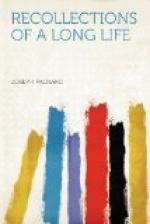THE DEANERY OF WESTMINSTER,
July 22, 1872
Dear Doctor—–Pray accept my sincere thanks for your very kind note. I quite appreciate your candor in mentioning what you thought a defect in my sermon. It arose from a fixed conviction which I have long formed, that the only chance there is of my sermons doing any good is by taking one topic at a time. The effect and the nature of the death of Jesus Christ, I quite agree with you in thinking to be a most important part of the Christian doctrine, and Christian history. But as my sermon was on a different subject—that of the right use of greatness—I felt that I could not speak, even by way of allusion, to the other great doctrine on which I had often preached before.
I sincerely wish that I could come
to America. Every
year that passes increases the number
of my kind friends
in the New World, and my desire
to see the United States.
Farewell; and may all the blessings
of our State and
Church follow you westward
Yours faithfully,
A.P. STANLEY.
When Dean Stanley visited America in the autumn of 1878, I met him several times, and he was especially cordial, and all the more so because of my out-spoken letter. The first time I met him was at the meeting of ministers of New York to give him a reception, and hear him deliver a discourse on Dr. Robinson, the Oriental geographer. He recognized me in the audience, came forward to the front of the platform, beckoned me up, and gave me a hearty grasp of the hand. I arranged to take him to Greenwood Cemetery on the morning before he sailed for home, and after breakfasting with him at Cyrus W. Field’s we started for the cemetery. Dr. Phillip Schaff and Dr. Henry M. Field met us at the ferry, and accompanied us. When we entered the elevated railroad car, Stanley exclaimed: “This is like the chariots on the walls of Babylon.” With his keen interest in history he inquired when we reached the lower part of the Bowery, near the junction of Chatham Square “Was it not near here that Nathan Hale, the martyr, was executed?” and he showed then a more accurate knowledge of our local history than one New Yorker in ten thousand can boast! That was probably the exact locality, and Dean Stanley had never been there before. Before entering the Greenwood Cemetery he requested me to drive him to the spot where my little child was buried, whose photograph in “The




